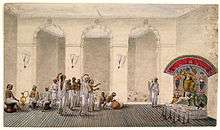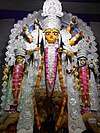Durga Puja
Durga Puja (pronounced [dʊrɡaː puːdʒaː]), also called Durgotsava (pronounced [dʊrɡoːtsəʋə]), is an annual Hindu festival originating in the Indian subcontinent which reveres and pays homage to the Hindu goddess, Durga.[2][3] It is particularly popular in the Indian states of West Bengal, Assam, Bihar, Tripura, and Odisha, the country of Bangladesh, and the diaspora from this region, and also in Nepal, where it is celebrated as Dashain. The festival is observed in the Indian calendar month of Ashwin, which corresponds to the months of September–October in the Gregorian calendar,[4][5] and is a ten-day festival,[6][2] of which the last five are of significance.[7][5] The puja is performed in homes and in the public, the latter featuring temporary stage and structural decorations (known as pandals). The festival is also marked by scripture recitations, performance arts, revelry, gift giving, family visits, feasting, and public processions. [2][8][9] Durga puja is an important festival in the Shaktism tradition of Hinduism.[10][11][12]
| Durga Puja | |
|---|---|
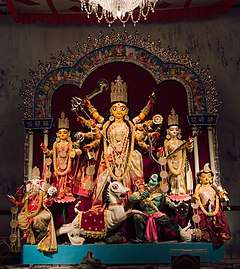 | |
| Observed by | Bengali, Odia, Maithils and Assamese communities as a socio-cultural and religious festival |
| Type | Hindu |
| Celebrations | Worshipping Hindu deities, family and other social gatherings, shopping and gift-giving, feasting, pandal visiting, and cultural events |
| Observances | Ceremonial worship of goddess Durga or Mahalakshmi |
| Begins | On the sixth day of Ashwin shukla paksha[1] |
| Ends | On the tenth day of Ashwin shukla paksha[1] |
| 2019 date | 4 October - 8 October |
| Frequency | Annual |
| Related to | Mahalaya, Navratri, Dussehra |
| Part of a series on |
| Shaktism |
|---|
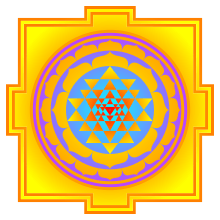 |
|
Schools |
|
Festivals and temples |
|
|
As per mythology, the festival marks the victory of goddess Durga in her battle against the shape-shifting asura, Mahishasura.[13][14][upper-alpha 1] Thus, the festival epitomises the victory of good over evil, though it is also in part a harvest festival celebrating the goddess as the motherly power behind all of life and creation.[16][17] Durga puja coincides with Navaratri and Dussehra celebrations observed by other traditions of Hinduism, in which the Ram lila dance-drama is enacted, celebrating the victory of Rama against Ravana, and effigies of Ravana are burnt.[18][19]
Though the primary goddess revered during Durga puja is Durga, the celebrations also include other major deities of Hinduism such as Lakshmi (the goddess of wealth, prosperity and the partial incarnation of Adi Shakti Mahalakshmi), Saraswati (the goddess of knowledge and music), Ganesha (the god of good beginnings), and Kartikeya (the god of war). In Bengali traditions, these deities are considered to be Durga's children and Durga puja is believed to commemorate Durga's visit to her natal home with her children.[20] The festival is preceded by Mahalaya, which is believed to mark the start of Durga's journey to her natal home. Primary celebrations begin on the sixth day (Shasthi), on which the goddess is welcomed with rituals.[3][5] The festival ends on the tenth day (Vijaya dashami), when devotees embark on a procession carrying the worshipped clay sculpture-idols to a river, or other water body, and immerse them, symbolic of her return to the divine cosmos and her marital home with Shiva in Kailash.[3][5] Regional and community variations in celebration of the festival and rituals observed exist.
Durga puja is an old tradition of Hinduism, though its exact origins are unclear. Surviving manuscripts from the 14th—century provide guidelines for Durga puja, while historical records suggest that the royalty and wealthy families were sponsoring major Durga puja festivities since at least the 16th-century.[10] The prominence of Durga puja increased during the British Raj in the provinces of Bengal and Assam.[21][3] In today's time, the importance of Durga puja is as much as a social and cultural festival as a religious one, wherever it is observed.
Over the years, Durga puja has become an inseparable part of Indian culture with innumerable people celebrating this festival in their own unique way while pertaining to tradition.[3]Durga puja is celebrated in WEST BENGAL ETC. Its significance is to mark the victory over Mahisasura demon.
Names
In West Bengal, Odisha, Assam, and Tripura, Durga puja is also called Akalbodhan (literally, "untimely awakening of Durga"), Sharadiya pujo ("autumnal worship"), Sharodotsab ("festival of autumn"), Maha pujo ("grand puja"), Maayer pujo ("worship of the Mother"), Durga pujo, or merely Puja or Pujo. In Bangladesh, Durga puja has historically been celebrated as Bhagabati puja.[22]
Durga puja is also referred to by the names of related Shakta Hindu festivals such as Navaratri, celebrated on the same days elsewhere in India;[3] such as in Bihar, Jharkhand, Gujarat, Uttar Pradesh, Punjab, Kerala, and Maharashtra,[upper-alpha 2] Kullu dussehra, celebrated in Kullu Valley, Himachal Pradesh;[upper-alpha 3] Mysore dussehra celebrated in Mysore, Karnataka;[upper-alpha 4] Bommai golu, celebrated in Tamil Nadu; Bommala koluvu, celebrated in Andhra Pradesh;[upper-alpha 5] and Bathukamma, celebrated in Telangana.
History and origins
Durga is an ancient deity of Hinduism according to available archeological and textual evidence. However, the origins of Durga puja are unclear and undocumented. Surviving manuscripts from the 14th-century provide guidelines for Durga puja, while historical records suggest the royalty and wealthy families to be sponsoring major Durga Puja public festivities, since at least the 16th-century.[10] The 11th or 12th-century Jain text Yasatilaka by Somadeva mentions an annual festival dedicated to a warrior goddess, celebrated by the king and his armed forces, and the description mirrors attributes of Durga puja.[4]
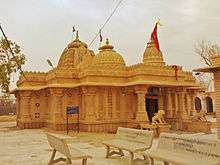
The name Durga, and related terms, appear in Vedic literature, such as in the Rigveda hymns 4.28, 5.34, 8.27, 8.47, 8.93 and 10.127, and in sections 10.1 and 12.4 of the Atharvaveda[25][26][upper-alpha 6] A deity named Durgi appears in section 10.1.7 of the Taittiriya Aranyaka.[25] While the Vedic literature uses the word Durga, the description therein lacks legendary details about her or about Durga puja that is found in later Hindu literature.[28]A key text associated with Durga puja is Devi Mahatmya, which is recited during the festival. Durga was likely well established by the time this Hindu text was composed, which scholars variously estimate to date between 400 and 600 CE.[29][30][31] The Devi Mahatmya mythology describes the nature of evil forces symbolised by Mahishasura as shape-shifting, deceptive, and adapting in nature, in form and in strategy to create difficulties and thus achieve their evil ends. Durga calmly understands and counters the evil in order to achieve her solemn goals.[13][14][upper-alpha 7]Durga, in her various forms, appears as an independent deity in the Indian texts.[32] Both Yudhisthira and Arjuna characters of the Mahabharata invoke hymns to Durga.[33] She appears in Harivamsa in the form of Vishnu's eulogy, and in Pradyumna's prayer. The prominent mention of Durga in such epics may have led to her worship.[34][4][35]
The Indian texts with mentions of Durga puja are inconsistent. A legend found in some versions of the Puranas mention it to be a spring festival, while the Devi-Bhagavata Purana and two other Shakta Puranas mention it to be an autumn festival. The Ramayana manuscripts are also inconsistent. Versions of Ramayana found in north, west, and south of the Indian subcontinent describe Rama to be remembering Surya (the Hindu sun god) before his battle against Ravana, but the Bengali manuscripts of Ramayana, such as the 15th-century manuscript by Krttivasa, mention Rama to be worshipping Durga.[36]According to some scholars, the worship of the fierce warrior goddess Durga, and her darker and more violent manifestation Kali, became popular in the Bengal region during and after the medieval era, marked by Muslim invasions and conquests.[37]
The significance of Durga and other goddesses in Hindu culture is stated to have increased after Islamicate armies conquered regions of the Indian subcontinent.[38] According to yet other scholars, the marginalisation of Bengali Hindus during the medieval era led to a reassertion of Hindu identity and an emphasis on Durga puja as a social festival, publicly celebrating the warrior goddess.[39]From the medieval era up to present-day, Durga puja has been celebrated as a socio-cultural event, while maintaining the roots of religious worship.[40]
Rituals and practices
Durga puja is a ten-day event, of which the last five days involve certain rituals and practices. The festival begins with Mahalaya, a day on which Hindus perform tarpaṇa by offering water and food to their dead ancestors. The day also marks the advent of Durga from her mythological marital home in Kailash.[3][5] The next significant day of the festival is the sixth day (Sashthi), on which devotees welcomes the goddess and festive celebrations are inaugurated. On the seventh day (Saptami), eighth (Ashtami) and ninth (Navami) days, the goddess along with Lakshmi, Saraswati, Ganesha, and Kartikeya are revered and these days mark the main days of worship with recitation of scriptures, puja, legends of Durga in Devi Mahatmya, social visits to elaborately decorated and illuminated pandals (temporary structures meant for hosting the puja), among others.[41][42][43]
Om you are rice [wheat...],Om you are life,you are the life of the gods,you are our life,your are our internal life,you are long life,you give life,Om the Sun with his rays (....)
— Hymn to start the Durga Puja,
Translator: David Kinsley[16]
Durga puja is, in part, a post-monsoon harvest festival observed on the same days in the Shaktism tradition of Hinduism as those in its other traditions.[44][45] The practice of including a bundle of nine different plants, called navapatrika, as a symbolism of Durga, is a testament practice to its agricultural importance.[16] The typically selected plants include not only representative important crops, but also non-crops. This probably signifies the Hindu belief that the goddess is "not merely the power inherent in the growth of crops but the power inherent in all vegetation".[16]The festival is a social and public event in eastern and northeastern states of India, where it dominates religious and socio-cultural life, with temporary pandals built at community squares, roadside shrines, and temples. The festival is also observed by some Shakta Hindus as a private home-based festival.[46]The festival is started at twilight with prayers to Saraswati.[47] She is believed to be another aspect of goddess Durga, and who is the external and internal activity of all existence, in everything and everywhere. This is typically also the day on which the eyes of the deities on the representative clay sculpture-idols are painted, bringing them to a lifelike appearance.[47][48] The day also marks prayers to Ganesha and visit to pandals temples.[49]Day two to five mark the remembrance of the goddess and her manifestations, such as Kumari (goddess of fertility), Mai (mother), Ajima (grandmother), Lakshmi (goddess of wealth) and in some regions as the Saptamatrikas (seven mothers) or Navadurga (nine aspects of Durga).[50][9][51] On the sixth day major festivities and social celebrations start. [3][5] The first nine days overlap with Navaratri festivities in other traditions of Hinduism.[52][19]The puja rituals involve mantras (words manifesting spiritual transformation), shlokas (holy verses), chants and arati, and offerings. These also include Vedic chants and recitations of the Devi Mahatmya text in Sanskrit.[43] The shlokas and mantras praise the divinity of the goddess; according to the shlokas Durga is omnipresent as the embodiment of power, nourishment, memory, forbearance, faith, forgiveness, intellect, wealth, emotions, desires, beauty, satisfaction, righteousness, fulfillment and peace.[53][upper-alpha 8] The specific practices vary by region.[57]
The rituals before the puja begins include the following:[58]
- Bodhana: Involves rites to awaken and welcome the goddess to be a guest, typically done on the sixth day of the festival.[59]
- Adhivasa: Anointing ritual wherein symbolic offerings are made to Durga, with each item representing a remembrance of subtle forms of her. Typically completed on the sixth day as well.[60]
- Navapatrika snan: Bathing of the navapatrika with holy water done on the seventh day of the festival.[61]
- Sandhi puja and Ashtami pushpanjali: The eighth day begins with elaborate pushpanjali rituals. The cusp of the ending of the eighth day and beginning of the ninth day is considered to be the moment when per mythology Durga engaged in a fierce battle against Mahishasura and was attacked by the demons Chanda and Munda. Goddess Chamunda emerged from the third eye of Durga and killed Chanda and Munda at the cusp of Ashtami and Navami, the eighth and ninth days respectively. This moment is marked by the sandhi puja, involving the offering of 108 lotuses and lighting if 108 lamps. It is a forty-eight minutes long ritual commemorating the climax of battle. The rituals are performed in the last 24 minutes of Ashtami and the first 24 minutes of Navami. In some regions, devotees sacrifice an animal such as a buffalo or goat, but in many regions, there isn't an actual animal sacrifice and a symbolic sacrifice substitutes it. The surrogate effigy is smeared in red vermilion to symbolize the blood spilled.[62] The goddess is then offered food (bhog). Some places also engage in devotional service.[63]
- Homa and bhog: The ninth day of festival is marked with the homa (fire oblation) rituals and bhog. Some places also perform kumari pujaon this day.[64]
- Sindoor khela and immersion: The tenth and last day, called Vijaya dashami is marked by sindoor khela, where women smear sindoor or vermillion on the sculpture-idols and also smear each other with it. This ritual signifies the wishing of a blissful marital life for married women. Historically the ritual has been restricted to married women. The tenth day is the day when Durga emerged victorious against Mahishasura and it ends with a procession where the clay sculpture-idols are ceremoniously taken to a river or coast for immersion rites.[65][66] Following the immersion, Durga is believed to return to her mythological marital home of Kailasha to Shiva and the cosmos in general. People distribute sweets and gifts, visit their friends and family members on the tenth day.[67] Some communities such as those near Varanasi mark the day after Vijaya dashami, called Ekadashi, by visiting a Durga temple.[68]
- Dhunuchi naach and dhuno pora: Dhunuchi naach involves a dance ritual performed with dhunuchi (incense burner). Drummers called dhakis, carrying large leather-strung dhak5 create music, to which people dance either during or not during aarati. Some places, especially home pujas, also observe dhuno pora, a ritual involving married women carrying dhunuchis burning with incense and dried coconuts, on a cloth on their head and hands,
Decorations, sculptures, and stages
The process of the creation of clay sculpture-idols (pratima or murti) for the puja, from the collection of clay to the ornamentation is a ceremonial process. Though the festival is observed post-monsoon harvest, the artisans begin making the sculpture-idols months before, during summer. The process begins with prayers to Ganesha and to the perceived divinity in materials such as bamboo frames in which the sculpture-idols are cast.[69]
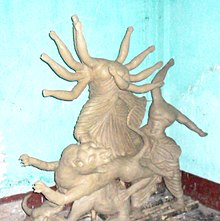
Clay, or alluvial soil, collected from different region form the base. This choice is a tradition wherein Durga, perceived as the creative energy and material, is believed to be present everywhere and everything in the universe.[69] In certain traditions in Kolkata, a custom is to include soil samples in the clay mixture for Durga from areas believed to be nishiddho pallis (forbidden territories; territories inhabited by the "social outcasts" such as brothels).[70]
The clay base is combined with straw, kneaded, and then molded into a cast made from hay and bamboo. This is layered to a fine final shape, cleaned, painted, and polished. A layer of a fiber called jute, mixed in with clay, is also attached to the top to prevent the statue from cracking in the months ahead. The heads of the statues are more complex, and are usually made separately.[69] The limbs of the statues are mostly shaped from bundles of straws.[69] Then, starting about August, the local artisans hand-paint the sculpture-idols which are later dressed in clothing, are decorated and bejewelled, and displayed at the puja altars.[69][71]
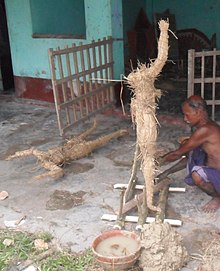
The procedure for and proportions of the sculpture-idols are described in arts-related Sanskrit texts of Hinduism, such as the Vishvakarma Sashtra.[72]
Environmental impact
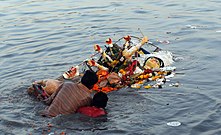
The sculpture-idols for the puja are traditionally made of biodegradable materials such as straw, clay, soil, and wood.[73] In today's times, brighter colored statues have increased in popularity and have diversified the use of non-biodegradable, cheaper or more colorful substitute synthetic raw materials. Environmental activists have raised concerns about the paint used to produce the statue, stating that the heavy metals in these paints pollute rivers when the statues are immersed at the end of the Durga festival.[73]
Brighter colors that are also biodegradable and eco-friendly, as well as the traditional natural colors, are typically more expensive compared to the non biodegradable paints.[74] The Indian state of West Bengal has banned the use of hazardous paints, and various state government have started distributing lead-free paints to artisans at no cost to prevent pollution.[75]
Animal sacrifice, symbolic sacrifice
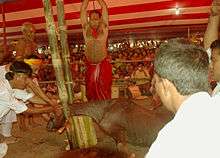
Shakta Hindu communities mark the slaying of Mahishasura and the victory of Durga with a symbolic or actual sacrifice. Most communities prefer symbolic sacrifice, where a statue of theasura is made of flour or equivalent, is immolated and smeared with vermilion, symbolic of the blood that had spilled during the battle.[62][76] Other substitutes include a vegetable or a sweet dish considered equivalent to the animal.[77] In certain instances, devotees consider animal sacrifice distasteful, and practice alternate means of expressing devotion while respecting the views of others in their tradition.[78]
In communities performing actual sacrifice, an animal is sacrificed, mainly at temples.[79] In Nepal, West Bengal, Odisha and Assam, animal sacrifices are performed at Shakta temples to commemorate the legend of Durga slaying Mahishasura.[80] This involves slaying of a fowl, goat or a male water-buffalo. This practice is rare among Hindus outside the regions of Bengal, Odisha, Bihar, and Assam.[81] In these regions, the festival season is primarily when significant animal sacrifices are observed.[81]
The Rajputs of Rajasthan worship their weapons and horses in the related festival of Navaratri, and some historically observed the sacrifice of a goat, a practice that continues in some places.[82][83] The sacrifice ritual, supervised he the priest, requires slaying of the animal with a single stroke. In the past this ritual was considered a rite of passage into manhood and readiness as a warrior.[84] The Kuldevi (clan deity) among these Rajput communities is a warrior goddess, with local legends tracing reverence for her during Rajput-Muslim wars.[85]
Pandals and theme-based pujas
Months before the start of Durga Puja, youth members of the community collect funds and donations, engage priests and artisans, buy votive materials and help build pandals centred around a theme, which has rose to prominence in recent years. Such themes have included sex work,[86] celebration of humanity,[87] marginalisation of queer persons and transgender persons,[88] folk culture,[89] celebration of cinema,[90] womanhood,[89] pro-environment themes,[91] while others have chosen metaphorical themes such as celebration of maati (literally, soil or ash) and "finding one's own light".[92] Pandals have also been replicated on existing temples, structures, and monuments[93][94] and yet others have been made of elements such as metal scraps,[95] nails,[96] and turmeric[97] among others. Durga puja pandals have also been centred around themes to acknowledge political events such as the 2019 Balakot airstrike and to protest against the National Register of Citizens of India.[98][99]
Designs and sculpture-idols are made by commissioned artisans, which is also a team effort involving labourers, architects, and community representatives hosting it. The budget required for such theme-based pujas is significantly higher than traditional pujas. For such theme-based pujas, the preparations and the building of pandals are a significant arts-related economic activity, often attracting major sponsors.[100] Such commercialised pujas attract crowds of visitors. The growth of competitiveness in theme-based pandals has escalated costs and scale of Durga puja in eastern states of India. Some segments of the society criticise the billboards, the economic competition, and seek return to basics.[101] The competition takes many forms, such as the height of statue. In 2015, an 88-foot statue of Durga in Kolkata's Deshapriya Park attracted numerous devotees, with some estimates placing visitors at one million.[102][103]
Regional celebrations and observances
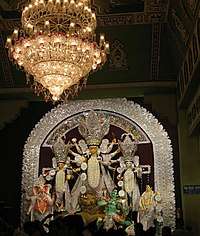
There exists variation in worship practices and rituals associated with Durga puja, as is the case with other Hindu festivals, in the Indian subcontinent.[104] Hinduism accepts flexibility and leaves the set of practices to the choice of the individuals concerned. Different localised rituals may be observed regionally, with these variations accepted across temples, pandals, and within families.[105] The festival is most commonly associated with Bengali Hindus, and with the community having variability and differences in practices. There may exist differences of practice between the puja of theme-based Pandals, family pujas (with puja of erstwhile aristocrat families known as bonedi puja), and community pujas (known as barowari pujas ) of neighbourhoods or apartments. [105]
The rituals of the puja also varies from being Vedic, Puranic, or Tantric, or a combination of these.[105] The Bengali Durga puja rituals typically combine all three. The non-Bengali Durga puja rituals tend to be essentially Vedic (srauta) in nature but they too incorporate esoteric elements making the puja an example of a culmination of Vedic-Tantric practices.[106]
Historical evidence suggests that the Durga puja has evolved over time, becoming more elaborate, social, and creative. The festival had earlier been a domestic puja, a form of practice that still remains popular. But it had also come to be celebrated in the sarvajanin (public) form, where communities get together, pool their resources and efforts to set up pandals and illuminations, and celebrate the event as a "mega-show to share".[107] The origins of this variation are unclear, with some sources suggesting a family in Kolkatta reviving such celebration in 1411 CE. While other set of sources suggest that a Bengali landlord, named Kamsanarayan, held a mega-show puja in late 16th-century Bengal.[107] Yet, this festival of Bengal is likely much older with the discovery of 11th and 12th-century Durga puja manual manuscripts such as Durgotsavaviveka, Durgotsava Prayoga, Vasantaviveka and Kalaviveka.[108] The rituals associated with the Durga puja migrated to other regions from Bengal, such as in Varanasi, a city that has historically attracted sponsorship from Hindus from various parts of the Indian subcontinent including Bengal.[109] In contemporary India, Durga puja is celebrated in various styles and forms.[110]
Durga puja is a widely celebrated festival in the Indian states of West Bengal, Bihar, Assam, and Odisha.[111] It is celebrated over a five-day period. Streets are decked up with festive lights, loudspeakers play festive songs as well as recitation of hymns and chants by priests, and pandals are erected by communities. The roads become overcrowded with revellers, devotees, and pandal-hoppers visiting the pandals on puja days. It often creates chaotic traffic conditions. Shops, eateries, and restaurants stay open all night; fairs are also set up and cultural programmes are held.[112] People form organizing committees, which plan and oversee the pandal during the festivities. Today, Durga Puja has turned into a consumerist social carnival, a major public spectacle and a major arts event riding on the wave of commercialisation, corporate sponsorship, and craze for award-winning. For private domestic pujas, families dedicate an area of their homes, known as thakur dalan, for Durga puja where the sculpture-idols for worship is placed and decorated with home-dyed fabric, sola ornamentations, and gold and silver foil decorations. Elaborate rituals like arati are performed and prasad is distributed after being offered to the deities. As a tradition, married daughters visit their parents and celebrate the Durga puja with them, a symbolism alluding to Durga who is popularly believed to return to her natal home during the puja.[113]
Durga Puja is also a gift-giving and shopping season for communities celebrating it, with people buying gifts for not only family members but also for close relatives and friends. New clothes are the traditional gift, and people wear them to go out together during Durga puja. During puja holidays, people may also go to places of tourist attractions while others return home to spend Durga puja with their family. [113] It's a common trend amongst youngsters and even those who are older to go pandal-hopping and enjoy the celebrations.[114]
The organising committees of each puja pandal hires a purohita (priest) who performs the puja rituals on behalf of the community.[115] For the priests, Durga puja is a time of activity wherein he pursues the timely completion of Vedic-Puranic-Tantric ritual sequences to make various offerings and perform fire oblations, in full public view, while the socio-cultural festivities occur in parallel.[116] The complex puja rituals include periods of accurate and melodic scripture recitation. The puja involves crowds of people visiting the pandals, with smaller groups visiting family pujas, to witness the celebrations.[117] On the last day, the sculpture-idols are carried out in immersion processions across Bengal, following which they are ritually immersed into rivers or other waterbodies. The immersion ceremony continues till a couple of days after the last day of puja. [118]

According to some scholars, the ritual of immersing the Durga sculpture-idol into the river attracted the attention of colonial era travelers to the Bengal region from Europe, such as Garcin de Tassy and Emma Roberts. In 1831, Tassy reported that similar rituals were annually observed by the Muslim community in Bengal. Shia Muslims observed Muharram over ten days, taking out processions in memory of the martyrdom of Imam Husayn ibn Ali, and then cast a memorial Imam's cenotaph into a river on the tenth day. Tassy further stated that the Muslim rituals included the same offerings at the annual observation of Muharram that the Hindu rituals included during Durga puja.[119] According to yet other scholars, the ritual of immersion in water by Hindus for Durga puja in Bengal and Ganesh Chaturthi in the western states of India, may have grown because members of the Hindu community attempted to create a competing procession and immersion ritual to that of Muharram, allowed by the colonial British Indian government in the 19th and early 20th-centuries.[120]
In Maharashtra, the city of Nashik and other places such as CIDCO, Rajeevnagar, Panchavati, and Mahatmanagar host Durga puja celebrations.[121] While in Delhi, the first community Durga puja was organised near Kashmiri Gate by a group of expatriate Bengalis, in 1910, a year before Delhi was declared the capital of British India. This group came to be the Delhi Durga Puja Samiti, popularly known as the Kashmere Gate Durga puja.[122] The Durga puja at Timarpur, Delhi was started in the year 1914.[123] In 2011, over 800 Durga pujas were held in Delhi, with a few hundred more in Gurgaon and NOIDA.[124]

In Odisha, in 2019, twenty-seven pandals in Cuttack, Odisha were reported to bedeck respective sculpture-idols with silver jewellery for Durga puja celebrations; such club of pandals termed regionally as Chandi Medha.[125] In September 2019, 160 pandals were reported to be hosting Durga puja in Cuttack.[126] While in Tripura there were over 2,500 community Durga puja celebrations in 2013. Durga puja has been started at the Durgabari temple, in Agartala by King Radha Kishore Manikya Bahadur.[127][128]
Significance
Beyond being an art festival and a socio-religious event, Durga puja has also been a political event with regional and national political parties having sponsored Durga puja celebrations. In 2019, West Bengal Chief Minister, Mamata Banerjee announced a grant of ₹25,000 to all community organised Durga pujas in the state.[129]
In 2019, Kolkata's Durga puja was nominated by the Indian government for the 2020 UNESCO Representative list of the Intangible Cultural Heritage of Humanity.[130][131] Durga puja also stands to be politically and economically significant. The committees organising Durga puja in Kolkata have close links to politicians.[87] Politicians patronise the festival by making donations or helping raise money for funding of community pujas, or by marking their presence at puja events and inaugurations.[87] The grant of ₹25,000 to puja organising committees in West Bengal by a debt-ridden state government was reported to cost a budget a ₹70 crores.[132] The state government also announced an additional grant of ₹5,000 to puja organising committees fully managed by women alone, while also announcing a twenty-five per-cent concession on total electricity bills for puja pandal.[132] The government had made a grant of ₹10,000 each to more than 20,000 puja organising committees in the state, in 2018.[132]
A 2013 report by ASSOCHAM states West Bengal's Durga puja to be a ₹25,000 crores worth economy, expected to grow at the compound annual growth rate of about 35 per-cent.[133] Economic slowdowns in India, such as in 2019, have hence affected corporate sponsorships and puja budgets for public celebrations.[134] In August 2019, the Income Tax Department of India had allegedly sent notices to various Durga puja organising committees in West Bengal, against which the ruling party of the state, All India Trinamool Congress (AITMC) protested.[135][136] The Central Board of Direct Taxes denied sending any such notices,[137] to which AITMC politician Madan Mitra is reported to have said that the intention may have been to enquire if tax deducted at source had been deducted on payments to vendors for organising community pujas.[87]
Media attention
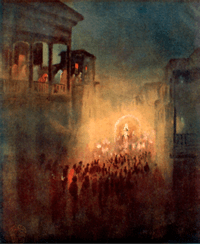
The day of Mahalaya is marked by the Bengali community with Mahishasuramardini — a two-hours long All India Radio programme — that has been popular in the Bengali community since the 1950s. While in earlier days it used to be recorded live, a pre-recorded version has come to be broadcast in recent decades. Bengalis traditionally wake up at four in the morning on Mahalaya to listen to the radio show, primarily involving recitations of chants and hymns from Devi Mahatmyam (or Chandi Path) by Birendra Krishna Bhadra and Pankaj Kumar Mullick. The show also features various devotional melodies.[138]
Dramas enacting the legend of Durga slaying Mahishasura are telecasted on the television. Radio and television channels also air other festive shows, while Bengali and Odia magazines publish special editions for the puja known as Pujabarshiki (Annual Puja Edition) or Sharadiya Sankhya (Autumnal Volume). These contain works of writers, both established and upcoming, and are more voluminous than the regular issues. Some notable examples of such magazines in Bengali are Anandamela, Shuktara, Desh, Sananda, Nabakallol, and Bartaman.[139]
Celebrations outside India
Durga puja is celebrated commonly by Bangladesh's Hindu community. Some Bengali Muslims also take part in the festivities.[140] In Dhaka, the Dhakeshwari Temple puja attracts visitors and devotees.[141] In Nepal, the festivities are celebrated as Dashain.[2][142]
Beyond south Asia, Durga puja is organised by Bengali communities in the United States of America.[143] Durga puja celebrations have also been started in Hong Kong by the Bengali diaspora.[144]
Celebrations are also organised in Europe. The sculpture-idols are shipped from India and stored in warehouses to be re-used over the years.[145] According to BBC News, for community celebrations in London in 2006, these "idols, belonging to a tableau measuring 18ft by 20ft, were made from clay, straw and vegetable dyes". At the end of the puja, the sculpture-idols were immersed in River Thames for the first time in 2006, after "the community was allowed to give a traditional send-off to the deities by London's port authorities".[145] In Germany, the puja is celebrated in Cologne,[146] and other cities. In Switzerland,[147] puja in Baden, Aargan has been celebrated since 2003. In Sweden, the puja is celebrated in cities such as Stockholm and Helsingborg.[148] In the Netherlands, the puja is celebrated in places such as Amstelveen, Eindhoven, and Voorschoten.[149][150]
Footnotes
- In the Shakta tradition of Hinduism, many of the stories about obstacles and battles have been considered as metaphors for the divine and demonic within each human being, with liberation being the state of self-understanding whereby a virtuous nature and society emerging victorious over the vicious.[15]
- Navratri Puja, Durga-puja.org
- Kullu Dussehra, Durga-puja.org
- Mysore Dussehra, Durga-puja.org
- "Bommai-kolu", Durga-puja.org
- Example Sanskrit original: "अहन्निन्द्रो अदहदग्निरिन्दो पुरा दस्यून्मध्यंदिनादभीके । दुर्गे दुरोणे क्रत्वा न यातां पुरू सहस्रा शर्वा नि बर्हीत्॥३॥ – Rigveda 4.28.8, Wikisource It appears in Khila (appendix, supplementary) text to Rigveda 10.127, 4th Adhyaya, per J. Scheftelowitz.[27]
- In the Shakta tradition of Hinduism, many of the stories about obstacles and battles have been considered as metaphors for the divine and demonic within each human being, with liberation being the state of self-understanding whereby a virtuous nature and society emerging victorious over the vicious.[15]
- Various versions of Devi mantra exist.[54] Examples include: [a] "We know the Great Goddess. We make a meditation of the goddess Durga. May that Goddess guide us on the right path. (Durga Gayatri Mantra, recited at many stages of Durga puja);[55] [b] Hrim! O blessed goddess Durga, come here, stay here, stay here, take up residence here, accept my worship. (Durga Avahana Mantra);[56] etc.
References
- Durga Puja Tithi.
- Lochtefeld 2002, p. 208.
- Bradley 2012, p. 214.
- Kinsley 1988, pp. 106-108.
- Encyclopedia Britannica 2015.
- Doniger 1999, p. 306.
- Parmita Borah (2 October 2011). "Durga Puja - a Celebration of Female Supremacy". EF News International. Archived from the original on 25 April 2012. Retrieved 26 October 2011.
- Melton 2011, pp. 239–241.
- Amazzone 2011, pp. 82-83.
- McDermott 2001, pp. 172-174.
- Foulston & Abbott 2009, pp. 162-169.
- Rodrigues 2003, pp. 7-8.
- Daniélou 1991, p. 288.
- McDaniel 2004, pp. 215-219.
- McDaniel 2004, pp. 20-21, 217-219.
- Kinsley 1988, pp. 111-112.
- Donner 2016, p. 25.
- Lochtefeld 2002, pp. 212-213.
- Jones & Ryan 2006, pp. 308-309.
- Kinsley 1988, p. 95.
- Durga Puja.
- Durga-puja.org 2012.
- Rocher 1986, pp. 191-195.
- Lawrence A. Babb; John E. Cort; Michael W. Meister (2008). Desert Temples: Sacred Centers of Rajasthan in Historical, Art-historical, and Social Context. Brill. pp. 8, 65–68, 86–89. ISBN 978-81-316-0106-8. Archived from the original on 18 February 2017. Retrieved 17 February 2017.
- Monier Monier-Williams (1899), Sanskrit English Dictionary with Etymology, Oxford University Press, page 487
- Maurice Bloomfield (1906), A Vedic concordance, Series editor: Charles Lanman, Harvard University Press, page 486;
- Scheftelowitz, J. (1906). Indische Forschungen. Verlag von M & H Marcus. pp. 112 line 13a.
- Kinsley 1988, pp. 95-96.
- Brown 1998, p. 77 note 28.
- Coburn 1991, pp. 13.
- Coburn 2002, pp. 1-7.
- McDermott 2001, p. 162.
- McDermott 2001, pp. 162-163.
- McDermott 2001, pp. 162-164.
- Kinsley 1997, pp. 16-22, 30-35.
- Brown 1990, pp. 280 note 50, 274 notes 103, 107, 109-110.
- Bandyopadhyay 1993, p. 118.
- Monaghan 2009, pp. 151–153.
- McDermott 2001, p. 330 notes 98-103.
- Bhattacharya, Tithi (November 2007). "Tracking the Goddess: Religion, Community, and Identity in the Durga Puja Ceremonies of Nineteenth-Century Calcutta". The Journal of Asian Studies. 66 (4): 919–962. JSTOR 20203237.
- Kinsley 1989, pp. 19-25.
- Kinsley 1988, pp. 106-115.
- Ghosa 1871, pp. 40–55.
- Amazzone 2012, pp. 55-59.
- Kinsley 1988, p. 111, Quote: "Durga Puja is celebrated from the first through the ninth days of the bright half of the lunar month of Asvin, which coincides with the autumn harvest in North India, and in certain respects it is clear that Durga Puja is a harvest festival in which Durga is propitiated as the power of plant fertility"..
- McLean 1998, p. 137.
- Amazzone 2012, pp. 57-59, 63, 66.
- Charles Russell Coulter & Patricia Turner 2013, pp. 148, 158-159, 256-257, 301.
- Amazzone 2012, pp. 58-60.
- Amazzone 2012, pp. 69-70, 83-84, 95-97, 115-117, 184.
- McDaniel 2004, pp. 209-210.
- Ellwood & Alles 2007, p. 126.
- Rodrigues 2003, pp. 50, 150-151.
- Brown 1990, pp. 143-147.
- Rodrigues 2003, pp. 153-155, 63, 90, 177 etc.
- Rodrigues 2003, p. 113.
- Rodrigues 2003, pp. 17-24, 31-39.
- Rodrigues 2003, pp. 71-74.
- Rodrigues 2003, pp. 38-44, 84-87.
- Rodrigues 2003, pp. 44-45, 120-127.
- Rodrigues 2003, pp. 46-54, 132-136.
- Rodrigues 2003, pp. 277-278.
- Rodrigues 2003, pp. 210-213.
- Rodrigues 2003, pp. 62-63, 224-229.
- Rodrigues 2003, pp. 244-245.
- McDaniel 2004, pp. 168-169.
- Rodrigues 2003, pp. 66-67, 236-241, 246-247.
- Rodrigues 2003, pp. 67-68.
- Chitgopekar 2009, pp. 95–98.
- Khanna 2015, p. 96.
- Amazzone 2012, p. 57.
- Rao 1988, pp. 47–49, 209.
- Chapple 2000, pp. 490, 484–489.
- Godfrey & Torres 2016, pp. 98–99.
- Ipsita Pati (October 18, 2012), Paint with toxic chemicals banned during Puja, The Hindu
- McDaniel 2004, pp. 204-205.
- McDermott 2011, pp. 204–205.
- Katznelson & Jones 2010, p. 343.
- Ghosa 1871, pp. 60–65.
- Phillips, Kerrigan & Gould 2011, pp. 98-101.
- Fuller 2004, pp. 46, 83–85.
- Harlan 2003, p. 22.
- Hiltebeitel & Erndl 2000, p. 77.
- Harlan 1992, pp. 61, 88.
- Harlan 1992, pp. 107–108.
- Das, Shreya (16 October 2018). "A Kolkata Durga Puja pandal pays tribute to sex workers". Indian Express. Retrieved 20 September 2019.
- Duttagupta, Ishani (25 August 2019). "Pandal Politics: Why this year's Durga Puja in Bengal is different". The Economic Times. Retrieved 18 September 2019.
- Das, Soumya (15 September 2018). "Durga Puja speaks for homosexuals, transgenders". The Hindu. Retrieved 1 October 2019.
- Dhar, Sujoy (12 October 2018). "Durga Puja theme & venues in South Kolkata". Times Travel. Retrieved 20 September 2019.
- "Durga puja in Delhi to bring alive 100-year journey of Bengali cinema". Times of India. 18 September 2019. Retrieved 20 September 2019.
- "Green themes abound in Durga Puja marquees". Business Standard. 14 October 2018. Retrieved 20 September 2019.
- Roy, Ujjainee (20 September 2019). "Durga Puja special: Watch out for this 12 landmark Pujas in Kolkata". Times of India. Retrieved 20 September 2019.
- "Photos: From Facebook to Lego: 15 interesting Durga Puja pandal themes we've seen over the years". News18. 25 September 2014. Retrieved 20 September 2019.
- Dhaor, Ashni (17 October 2018). "Your guide to pandal hopping in Noida". Times of India. Retrieved 20 September 2019.
- "Durga Puja: Pandal made from scrap, spare parts glitters in Kolkata". Business Standard. 11 October 2018. Retrieved 20 September 2018.
- Bose, Rakhi (16 October 2018). "In Kolkata, a Durga Puja Pandal Crafted Out of Nails and Threads to Make it 'Visible' to the Blind". News18. Retrieved 20 September 2019.
- Mehta, Puja (12 October 2018). "In West Bengal, a Durga Puja pandal made out of turmeric". DNA. Retrieved 20 September 2018.
- "Terrorists vs Abhinandan Varthaman: Balakot airstrikes becomes theme for Durga Puja pandal". India Today. 15 September 2019. Retrieved 20 September 2019.
- Bhattacharjee, Satananda (18 September 2019). "Novel NRC protest at puja pandals". The Telegraph. Retrieved 20 September 2019.
- Rodrigues 2003, pp. 1-2, 10-11, 24-26, 351-352.
- Billboards 2009.
- Have you ever.
- Near stampede shuts.
- Rodrigues 2003, p. 17.
- Rodrigues 2003, pp. 17-18.
- Rodrigues 2003, p. 18.
- Rodrigues 2003, pp. 18-19.
- McDermott 2011, pp. 12-14.
- Rodrigues 2003, pp. 20-27.
- Rodrigues 2003, pp. 17-21.
- McDermott 2011, p. 11.
- Rodrigues 2003, pp. 27-28.
- Rodrigues 2003, pp. 27-29.
- McDermott 2011, pp. 138-143.
- Rodrigues 2003, pp. 27-30.
- Rodrigues 2003, pp. 27-30, 39-48, 58-64, 106-114.
- Rodrigues 2003, pp. 27-32.
- Rodrigues 2003, pp. 27-32, 64-75.
- Alexander, Chatterji & Jalais 2016, pp. 190 note 76.
- Jones & Michele Marion 2014, pp. 97–98.
- Sarkar 2015.
- Durga Puja 2009.
- Roy 2011.
- Bamboo barricading in 2011.
- "Three more 'Chandi Medha' to adorn Silver City's Durga Puja celebration". New Indian Express. 13 September 2019. Retrieved 18 September 2019.
- "Bad roads dampen spirit of Cuttack's Millennium City Durga Puja organisers". New Indian Express. 11 September 2019. Archived from the original on 13 September 2019. Retrieved 18 September 2019.
- Durga Puja, Durga.
- Durga Puja begins.
- "Durga Puja in West Bengal turns political battlefield between BJP and Trinamool Congress". Orissa Post. PPN and Agencies. 16 September 2019. Retrieved 18 September 2019.
- "Kolkata Durga Puja nominated for UNESCO Intangible Cultural Heritage list". The Statesman. 2 April 2019. Retrieved 18 September 2019.
- Srivastava, Vanita (1 April 2019). "Kolkata's Durga Puja nominated for Unesco list". Hindustan Times. Retrieved 18 September 2019.
- Mehta, Pooja (31 August 2019). "Debt-ridden Mamata Banerjee govt 'gifts' Rs 70 crore to West Bengal Durga Puja organisers". Zee News India. Retrieved 18 September 2019.
- Kundu, Indrajit (12 September 2019). "Bengal's Durga puja loses sheen due to economic slowdown". India Today. Retrieved 18 September 2019.
- Rakshit, Avishek (14 September 2019). "Economic slowdown cloud on Bengal's Durga Puja; sponsorship takes a hit". Business Standard. Retrieved 18 September 2019.
- "'No tax on Durga Puja committees': TMC on day-long protest as Mamata sets stage for fresh clash with Centre over I-T notices". Financial Express. 13 August 2019. Retrieved 18 September 2019.
- "IT dept's taxation of Durga Puja irks Mamata". The Hindu. 11 August 2019. Retrieved 18 September 2019.
- "CBDT denies reports of issuing tax notices to Durga Puja committees in Kolkata". Business Today. PTI. 13 August 2019. Retrieved 18 September 2019.
- Mahalaya ushers in 2009.
- Pujabarshiki.
- Tripathi 2016, p. 5.
- London 2004, p. 38.
- J. Gordon Melton 2011, pp. 239–241.
- Ghosh 2016.
- Hkyantoyan Hong Kong.
- Bbc Thames immersion 2006.
- Indische Kultur Verein.
- Durga Puja in.
- [[#CITEREFHome_|_Bengali|Home | Bengali]].
- [[#CITEREFHoichoi_|_Bengali|Hoichoi | Bengali]].
- Home.
Bibliography
- Alexander, Claire; Chatterji, Joya; Jalais, Annu (2016). The Bengal Diaspora. Rethinking Muslim Migration. Routledge. ISBN 978-0-415-53073-6.
- Amazzone, Laura (2012). Goddess Durga and Sacred Female Power. University Press of America. Retrieved 5 February 2017.
- Amazzone, Laura (2011). Patricia Monaghan (ed.). Goddesses in World Culture. ABC-CLIO. ISBN 978-0-313-35465-6.
- Bandyopadhyay, Pranab (1993). Mother Goddess Kali. UW Press. ISBN 978-81-85328-15-7.
- Banerji, Chitrita (2006). The Hour of the Goddess: Memories of Women, Food, and Ritual in Bengal. Penguin Books India. ISBN 978-0-14-400142-2.
- Bradley, Cynthia (2012). Denise Cush; Catherine Robinson; Michael York (eds.). Encyclopedia of Hinduism. Routledge. ISBN 978-1-135-18979-2.
- Brooks, Douglas Renfrew (1992). Auspicious Wisdom. State University of New York Press. ISBN 978-0791411452.
- Brown, C Mackenzie (1990). The Triumph of the Goddess: The Canonical Models and Theological Visions of the Devi-Bhagavata Purana. State University of New York Press. ISBN 978-0-7914-0364-8.
- Brown, Cheever Mackenzie (1998). The Devi Gita: The Song of the Goddess: A Translation, Annotation, and Commentary. State University of New York Press. ISBN 978-0-7914-3939-5.
- Chapple, Christopher (2000). Hinduism and ecology: the intersection of earth, sky, and water. Harvard University Press. ISBN 978-0-945454-25-0.
- Chitgopekar, Nilima (20 July 2009). Book Of Durga. Penguin Books India. pp. 111–. ISBN 978-0-14-306767-2.
- Coburn, Thomas B. (1991). Encountering the Goddess: A translation of the Devi-Mahatmya and a Study of Its Interpretation. State University of New York Press. ISBN 0791404463.
- Coburn, Thomas B. (2002). Devī Māhātmya, The Crystallization of the Goddess Tradition. South Asia Books. ISBN 81-208-0557-7.
- Charles Russell Coulter; Patricia Turner (2013). Encyclopedia of Ancient Deities. Routledge. ISBN 978-1-135-96397-2.
- Reid-Bowen, Paul (2012). Denise Cush; Catherine Robinson; Michael York (eds.). Encyclopedia of Hinduism. Routledge. ISBN 978-1-135-18979-2.
- Daniélou, Alain (1991). The Myths and Gods of India: The Classic Work on Hindu Polytheism from the Princeton Bollingen Series. Inner Traditions / Bear & Co. ISBN 978-0-89281-354-4.
- Doniger, Wendy (1999). Merriam-Webster's Encyclopedia of World Religions. Merriam-Webster. ISBN 978-0-87779-044-0.
- Donner, Henrike (2016). Domestic Goddesses: Maternity, Globalization and Middle-class Identity in Contemporary India. Routledge. ISBN 978-1-317-14848-7.
- Ellwood, Robert S; Alles, Gregory D (2007). The Encyclopedia of World Religions. Infobase Publishing. ISBN 978-1-4381-1038-7.
- Foulston, Lynn; Abbott, Stuart (2009). Hindu Goddesses: Beliefs and Practices. Sussex Academic Press. ISBN 978-1-902210-43-8.
- Fuller, Christopher John (2004). The Camphor Flame: Popular Hinduism and Society in India. Princeton University Press. ISBN 978-0-69112-04-85.
- Ghosa, Pratapacandra (1871). Durga Puja: with notes and illustrations. Calcutta: Hindoo Patriot Press.
- Godfrey, Phoebe; Torres, Denise (2016). Emergent Possibilities for Global Sustainability: Intersections of Race, Class and Gender. Routledge. ISBN 978-1-317-57017-2.
- Harlan, Lindsey (2003). The Goddesses' Henchmen: Gender in Indian Hero Worship. Oxford University Press. ISBN 978-0-19-534834-7.
- Harlan, Lindsey (1992). Religion and Rajput Women: The Ethic of Protection in Contemporary Narratives. University of California Press. ISBN 978-0-520-07339-5.
- Hiltebeitel, Alf; Erndl, Kathleen M. (2000). Is the Goddess a Feminist?: The Politics of South Asian Goddesses. New York University Press. ISBN 978-0-8147-3619-7.
- Katznelson, Ira; Jones, Gareth Stedman (2010). Religion and the Political Imagination. Cambridge University Press. ISBN 978-1-139-49317-8.
- Jones, Constance; Ryan, James D (2006). Encyclopedia of Hinduism. Infobase Publishing. ISBN 978-0-8160-7564-5.
- Kinsley, David (1989). The Goddesses' Mirror: Visions of the Divine from East and West. State University of New York Press. ISBN 978-0-88706-835-5.
- Kinsley, David (1988). Hindu Goddesses: Visions of the Divine Feminine in the Hindu Religious Tradition. University of California Press. ISBN 978-0-520-90883-3.
- Kinsley, David (1997). Tantric Visions of the Divine Feminine: The Ten Mahavidyas. University of California Press. ISBN 978-0-520-91772-9.
- Lochtefeld, James G (2002). The Illustrated Encyclopedia of Hinduism: A-M. The Rosen Publishing Group. ISBN 978-0-8239-3179-8.
- McDaniel, June (2004). Offering Flowers, Feeding Skulls: Popular Goddess Worship in West Bengal. Oxford University Press. ISBN 978-0-19-534713-5.
- Khanna, Vikas (2015). Indian Harvest: Classic and Contemporary Vegetarian Dishes. Bloomsbury Academic. ISBN 978-1-63286-200-6.
- McDermott, Rachel Fell (2001). Mother of My Heart, Daughter of My Dreams: Kali and Uma in the Devotional Poetry of Bengal. Oxford University Press. ISBN 978-0-19-803071-3.
- McDermott, Rachel Fell (2011). Revelry, Rivalry, and Longing for the Goddesses of Bengal: The Fortunes of Hindu Festivals. Columbia University Press. ISBN 978-0-231-12919-0.
- McLean, Malcolm (1998). Devoted to the Goddess: The Life and Work of Ramprasad. State University of New York Press. ISBN 978-0-7914-3689-9.
- Melton, J. Gordon (2011). Religious Celebrations: An Encyclopedia of Holidays, Festivals, Solemn Observances, and Spiritual Commemorations. ABC-CLIO. ISBN 978-1-59884-206-7.
- Monaghan, Patricia (2009). Encyclopedia of Goddesses and Heroines. ABC-CLIO. ISBN 978-0-313-34990-4.
- Monaghan, Patricia (2011). Goddesses in World Culture. ABC-CLIO. ISBN 978-0-313-35465-6.
- Sree Padma (2014). Inventing and Reinventing the Goddess: Contemporary Iterations of Hindu Deities on the Move. Lexington Books. ISBN 978-0-7391-9002-9.
- Phillips, Charles; Kerrigan, Michael; Gould, David (2011). Ancient India's Myths and Beliefs. The Rosen Publishing Group. ISBN 978-1-4488-5990-0.
- Rao, Saligrama Krishna Ramachandra (1988). Pratima Kosha: Descriptive Glossary of Indian Iconography. IBH Prakashana.
- Rocher, Ludo (1986). The Puranas. Otto Harrassowitz Verlag. ISBN 978-3447025225.
- Sen Ramprasad (1720–1781). Grace and Mercy in Her Wild Hair: Selected Poems to the Mother Goddess. Hohm Press. ISBN 0-934252-94-7.
- Rodrigues, Hillary (2003). Ritual Worship of the Great Goddess: The Liturgy of the Durga Puja with Interpretations. SUNY Press. ISBN 978-0-7914-8844-7.
- "Durga - Hindu mythology". Encyclopedia Britannica. 19 February 2015. Retrieved 15 February 2017.
Further reading
- Banerjee, Sudeshna (2004). Durga Puja: Yesterday, Today and Tomorrow. Rupa and Co, Calcutta. ISBN 81-291-0547-0.
- Bhattacharyya, BK (6 October 2008). "Earthen sculptures of Goddess Durga". The Assam Tribune. Archived from the original on 1 April 2012.
- Dutta, Krishna. (2003) Calcutta: a cultural and literary history. Signal Books, Oxford, United Kingdom. ISBN 1-902669-59-2.
- Muthukumaraswamy, M.D.; Kaushal, Molly (2004). Folklore, public sphere, and civil society. National Folklore Support Centre(India). ISBN 978-81-901481-4-6. (Chapter 6: "Of Public Sphere and Sacred Space: Origins of Community Durga Puja in Bengal.")
- Saraswati, Swami Satyananda (2001). Durga Puja Beginner, Devi Mandir. ISBN 1-887472-89-4.
External links
- Durga Puja at Curlie


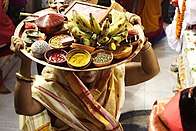
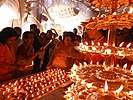
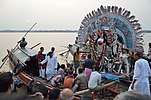

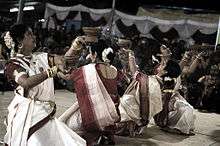
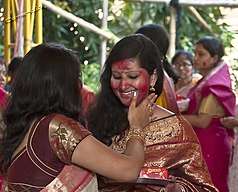


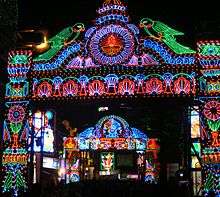

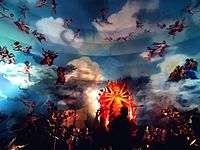
.jpg)
